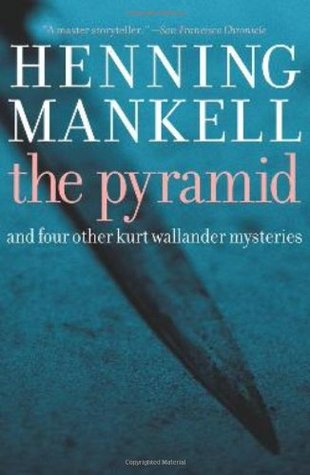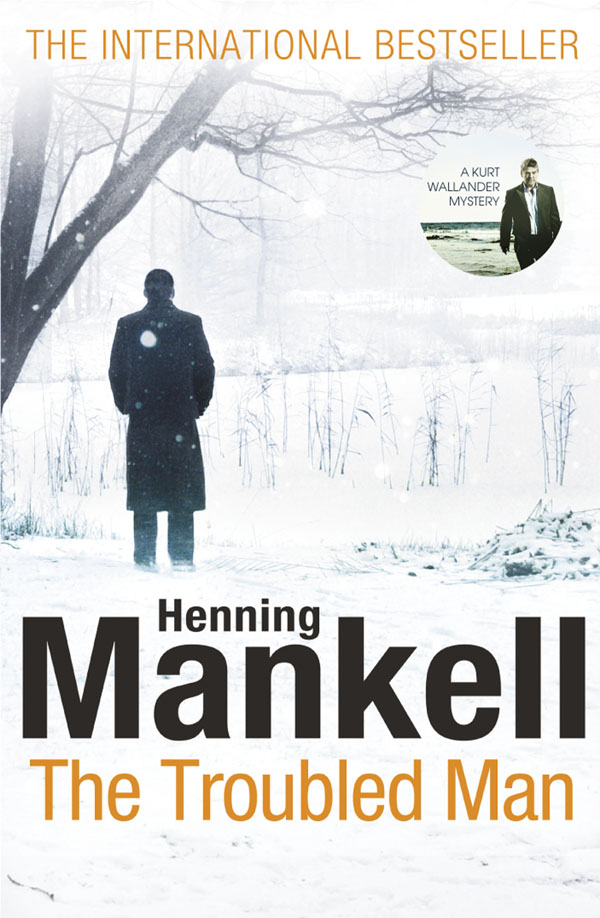Henning Mankell
Books: Mystery
Kurt Wallander: The Fifth Woman (1996/2000), Pyramid: And Four Other Kurt Wallander Mysteries (1999), The Troubled Man (2009/2011)
Kurt Wallander
The Fifth Woman (1996/2000) translated by Steven T. Murray
 This is the first Kurt Wallander I've read, and I wonder how I've gone so long without reading him before.
This is the first Kurt Wallander I've read, and I wonder how I've gone so long without reading him before.
This is almost the definition of police procedural, and what we see is something that looks like what we'd actually see in a police investigation: long hours of meetings, huge stacks of reports to be sifted through, and other events happening at the same time that have to be dealt with.
This is actually the sixth book in the series, but I didn't have any problems falling into the characters or setting (I find this to be common with mysteries).
The story opens with Kurt finishing up a vacation in Rome with his father–the last trip his father is likely to take, as the symptoms of Alzheimer's take over his life.
Old age was dangerous; it held diseases and death, dark graves and fear.
It is made clear that Kurt has had a difficult relationship with his father in the past, and this vacation is something they both enjoyed, both for the trip and for the easy relationship the have while they travel.
But after he returns Ystad , Sweden, thinking he'll only take up the never-ending case of illegal car imports, an old man is reported missing, and a brutal–horrific–murder is discovered.
"It sounds like some kind of torture chamber dug into a field in Skane."
"Those are your words, not mine."
"What are your words, then?"
"That there will be a press conference on Monday."
What I particularly liked about this story are the dead ends that they have to follow up in their search of the murderer.
He thought that his work was basically nothing more than a poorly paid test of endurance. He was being paid to endure this.
But it wasn't all the mystery of course. Wallander is a fascinating and complex individual, who may be absorbed by his job, but still have a complicated life.
In this story, we catch glimpses of the woman who is committing these murders, but that doesn't answer why she is killing, and although we see the event that sets her off, it doesn't truly explain anything.
All in all, I was delighted by this book, and definitely want to read more of this series.
Published by New Press
December 2013 | Rating: 9/10
Pyramid: And Four Other Kurt Wallander Mysteries (1999) translated by Ebba Segerberg and Laurie Thompson
 These are four Wallander stories: Wallander's First Case, The Man with the Mask, The Man on the Beach, The Death of the Photographer.
These are four Wallander stories: Wallander's First Case, The Man with the Mask, The Man on the Beach, The Death of the Photographer.
Wallander's First Case, set in June 1969 finds Wallander just starting out as a police officer, and just starting to woo his future wife Mona–you can see here that the marriage will be troubled.
Mona liked going out to dinner, but Wallander thought it was throwing away money for no reason.
We see Wallander meet his mentor, and see how he fell into investigation.
The Man with the Mask, set in December 1975, finds Wallander married to Mona and living in Malmo.
"In the past, people stole hand-cranked record players. You didn't steal car stereos, for the simple reason that they didn't exist."
It's interesting to see how frequently people bemoan the decay of civilization and look fondly back at the good-old-days, which really weren't that good.
The Man on the Beach, is set in 1987, and finds Wallander in Ystad, with Mona and Linda away on a vacation that is really a trial separation.
"Did he have any children?
"One son."
"We'd better find him, then."
"That won't be possible," Hansson said.
"Why not?"
"Because he's dead." Wallander could sometimes get very annoyed by Hansson's roundabout way of coming to the point. This was one of those occasions.
The Death of the Photographer, is set in April 1988 in Ystad. Was the most interesting mystery of the stories. Not to say that the other stories were not good, because they were, but this was a very interesting mystery, and you get a good look at the long and slow process of how the mystery is solved.
I've only read two Wallander books, once of which was the final book, so it was nice to read these stories, to get an idea of how Wallander worked and what interested him.
Published by The New Press
January 2016 | Rating: 8/10
The Troubled Man (2009/2011) translated by Laurie Thompson
 I've been in a mood lately where I don't know what I want to read. I have several new releases I have been waiting for, but they just don't appeal to me for some unknown reason.
I've been in a mood lately where I don't know what I want to read. I have several new releases I have been waiting for, but they just don't appeal to me for some unknown reason.
So I randomly chose The Troubled Man because I enjoyed The Fifth Woman.
I didn't realize how late this was in the series.
It takes quite a long time for the actual mystery to start, and the prologue, which give you hints as to where things are going, seems unrelated to anything that happens at the start of the story.
Instead, we spend time with Kurt Wallander, as he is approaching the end of his career. He is fifty-five, and reflects upon what the future might hold.
He looked down into the swirling water and thought about how his life was now centered increasingly on recalling things from the past that he now realized he missed.
What I found so fascinating about this story was how the hints were there from the start as to how things were going to end, but you're so blinded by everything else, you don't pay much attention.
SPOILER
The book ends with Wallander's diagnosis of Alzheimer's. We've seen the signs from the start of the story, but this is a mystery series. No one consigns their hero to dementia. Yes, his blackouts are a concern, but he has diabetes, and is terrible about watching his blood sugar, so surely these blackouts and lapses can be attributed to that.But no. Instead we discover we have been watching him slowly lose his mind, succumbing to the first stages of dementia.
END SPOILER
I found it incredibly moving, and terribly heart-breaking, all at the same time.
I was also fascinated by the commentary on Russia, considering the present.
"Berntsius maintained it was a big mistake to believe that Russia would always be as peaceful as it is now."
"Secret police organizations never die. They change names, but they are always there. Anybody who thinks there's less spying in the world today just doesn't get it. Don't forget that quite a few of the old masters are still around."
When the Russian empire collapsed, a revolution took place that was every bit as shattering as the events of 1917. But according to George it was only a temporary setback. He thinks the current situation confirms that view: Russia is growing stronger and stronger and making ever greater demands on the world around it.
Considering current events, he seems disconcertingly prescient. Yes, I don't think anyone ever believed that Putin was sunshine and light (except, perhaps, W.) but I also don't think we expected to return to come so quickly.
But I digress.
The mystery is fascinating, and incredibly complex, but for me that was secondary to the look at Wallander and his life.
Although this is book 10, and I'd only read one other book in this series, I didn't at all feel lost in the story, or as if I was missing a background, and so I can highly recommend this book to anyone, whether they've read any of the series or not.
Published by Vintage
November 2014 | Rating: 9/10
